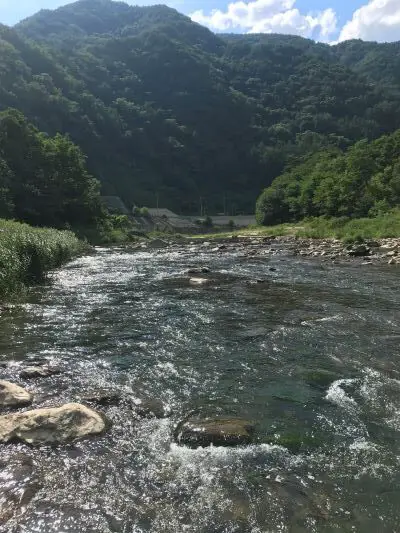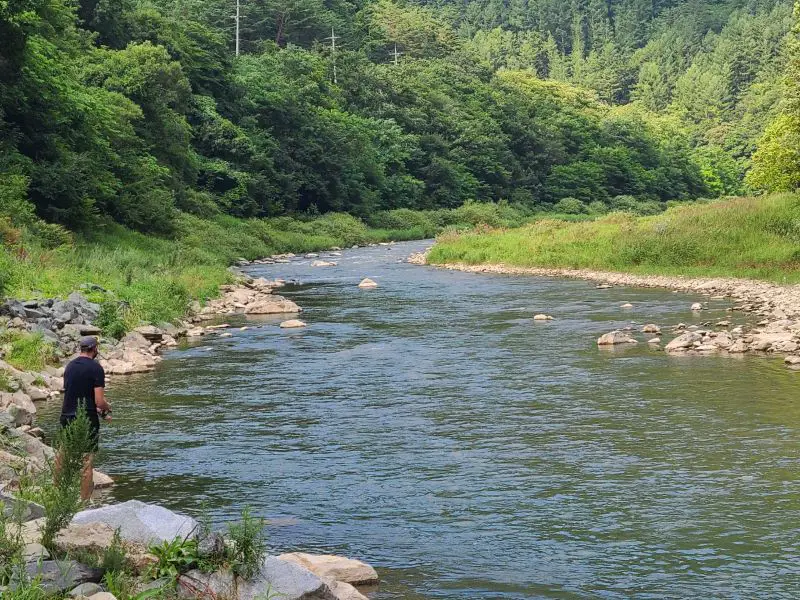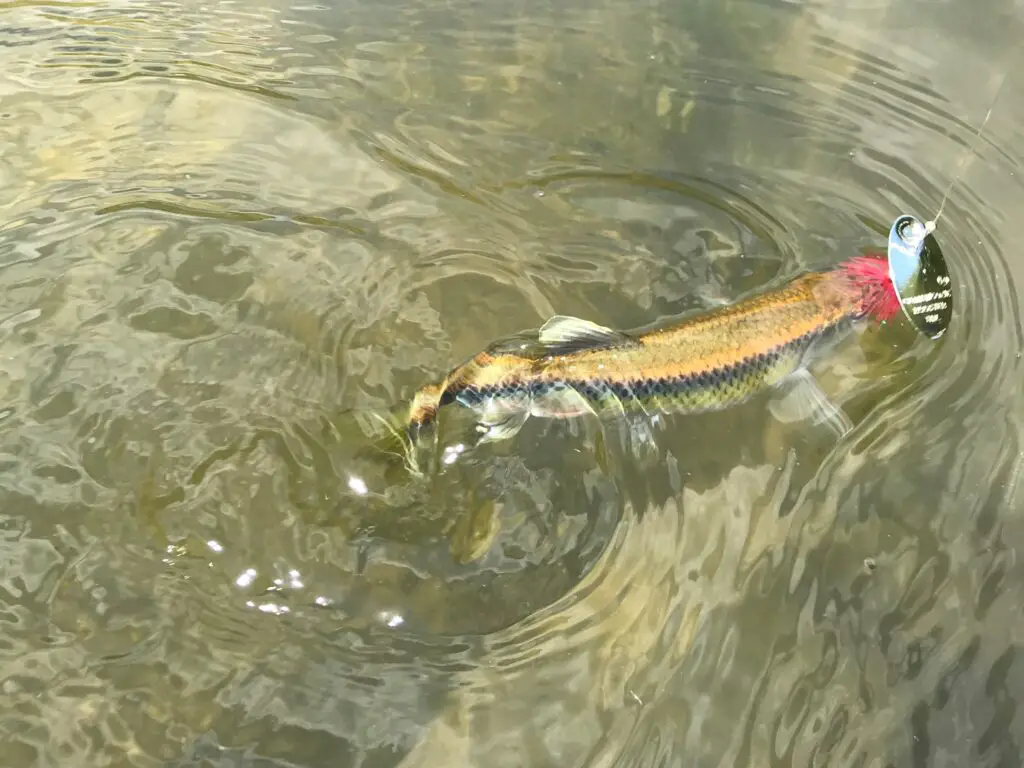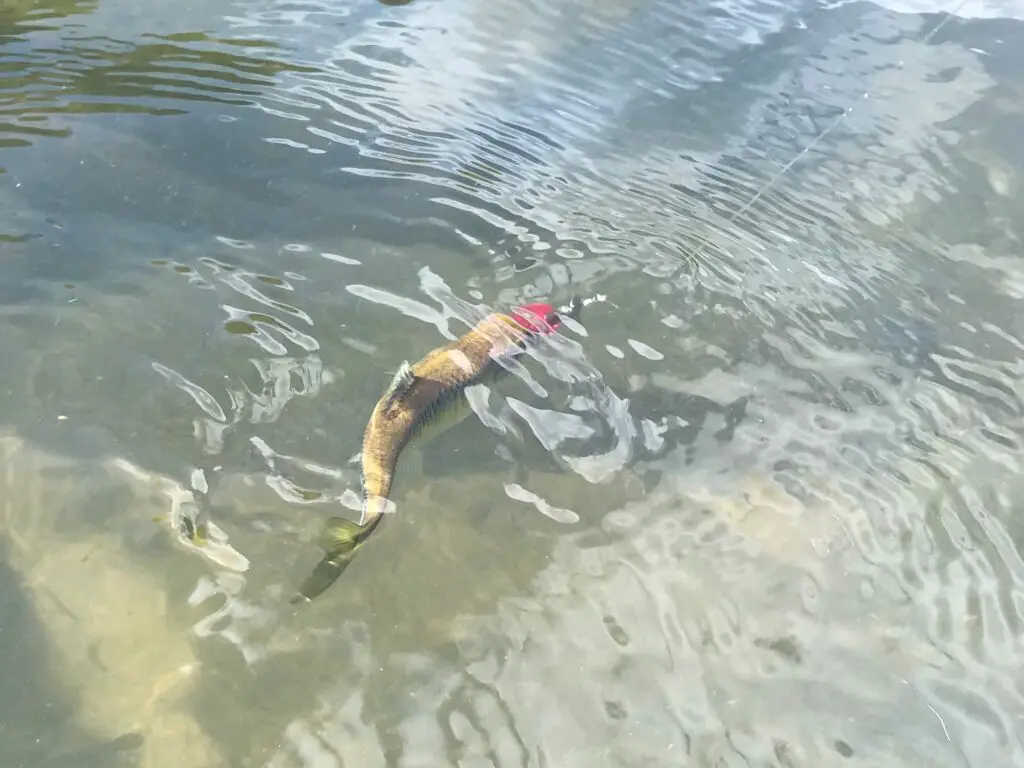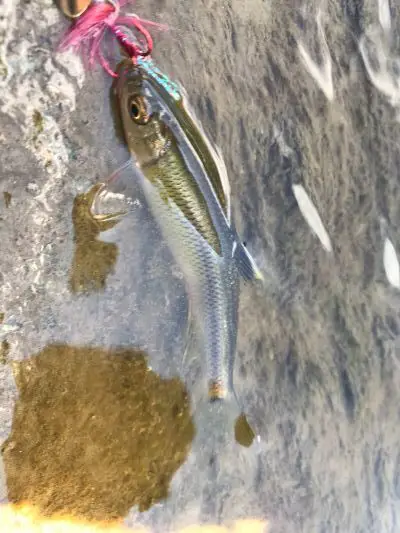I have been living in Korea for close to a year, and still have not found the time to check out the trout streams. Which are located on the eastern side of the country and are a closely guarded secret.
Last weekend, I found myself camping beside a river that just ‘screamed’ trout. Like any trout fishing tragic, I just had to wet a line.
Trout Species of Korea
I have had plenty of time to research, plan, and translate.
So I had a fair idea where to find them. Korea has two species of native trout, the more common of which in English is the Cherry Trout but more correctly known as the Masu Salmon (Oncorhynchus masou). These remind me a lot of rainbow trout, they do belong to the same genus after all. Some sea run fish grow large and get referred to as Cherry Salmon.
The other species of trout found in Korea is the Manchurian Brown trout or Lenok (Brachymystax tumensis). Unfortunately, development has not been kind on the Lenok.
Korea has heavily modified all of their major rivers. Combined with water extraction for irrigation, and fertilizer runoff has resulted in localized extinctions offs of all but the hardest of fish species.
The Lenok, like all trout like cold, clean water. That is a rarity in Korea. Lenok populations are now restricted to only a handful of small mountain streams, although healthier populations remain in other east Asian countries.
The last trout found in Korea are stock and escaped populations of Rainbow Trout. Like the other trout, Rainbow trout, outside of paid pones in winter are usually restricted towards the headwaters where the water is cold and pristine.
My first visit to a trout River
Waterfall pool
Since moving to Korea a little over a year ago, my life has been busy. Other commitments have prevented me from making the several hour drive to go trout fishing.
Last weekend, while visiting family at a swimmable waterfall on the east coast I wondered if the nearby river could hold trout.
Upon, arriving at the river. My first decision was to cool off in the plunge pool beneath the waterfall. In this small side stream, the water was cold, fresh and clean enough for me to dive towards the bottom. There I saw it a small pool teeming with fish life. I saw numerous chubbs, and what appears to be juvenile cherry trout.
That was enough to excite my interest to properly fish the main river.
First impressions – How I go about reading a new river
I can tell a lot about a river just by looking at it. My first impression of the main river was positive.
The river flows quite rapidly through a series of swift pools, and short rapids. Many large boulders create tempting looking pocket water even in the more turbulent of runs.
On touching the water, I lost some hope. It was warm, almost too warm for trout fishing. If I do fish, I will have to be careful to land and release any trout quickly to minimize any stress they might be under. Taking them out of the water for a photo was certainly not an option.
By far the most promising looking area of the river, was at the mouth of the small stream. There the cold mountain water flows merges with the warm flow of the main river.
In warm summer conditions, trout and most fish species seek out the cooler more oxygen rich waters of tributaries. The previous weekend in Seoul, I saw dozens of carp doing exactly that at the mouth of a urban stream flowing directly into the Han River.
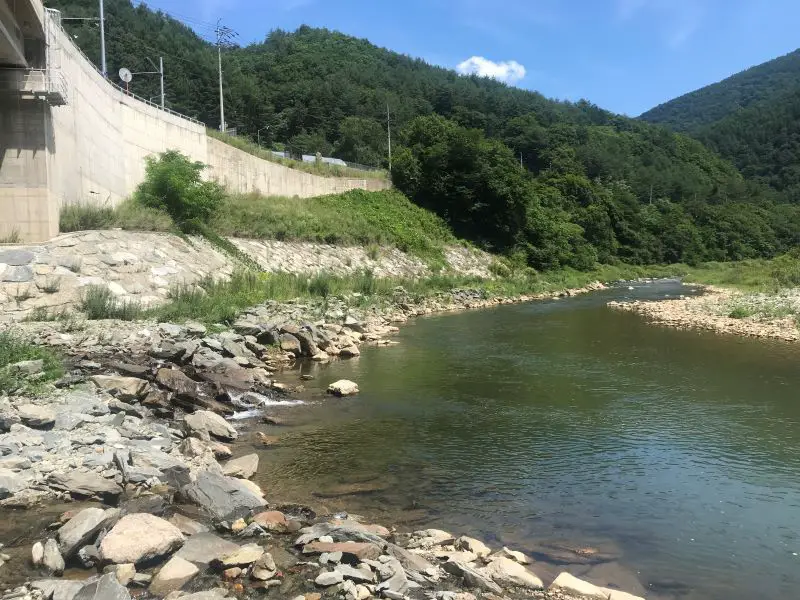
Choosing the correct tackle
I have done quite a bit of research surrounding trout fishing in Korea. Koreans fish for trout in several ways, like in the west Fly fishing is popular. With many trout being caught on dry flies. While I do fly fish, I did not have my fly rod with me.
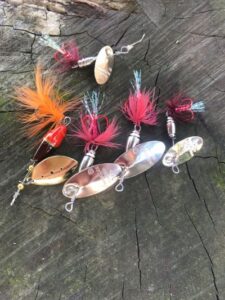
So I was forced to fish with spinning gear. That was not a bad thing, when first scouting a new river, I like to spinfish it.
Spinning allows me to cover a lot of water quickly, just to learn where the fish are holding. On future trips, I will return and more skillfully work the more promising areas.
In Korea, I thought it will be a good idea to fish with Korean Tackle. The tackle shops in Korea are a sight to behold. With row upon row of various minnows, jerkbaits and crankbaits. I have never seen a bigger selection and most of the top brands were present.
I love fishing jerkbaits for trout, but I have different plans. So I found my way to a dusty, forgotten corner of a fishing store to purchase myself a few spinners. There were around 5 different models and a few sizes.
In-line spinners do not seem to be a popular choice for Korean anglers. They mostly prefer small jerkbaits or even bait.
This knowledge gave me the confidence to fish inline spinners, simply because any trout are less likely to have seen them before. When targeting potentially wary fish, I like to present tackle and techniques they have never seen before. We all know that trout can not resit the thud and flash of a quality spinner and doubt Korean trout will be any different.
Now, the selection of in-line spinners was poor. All the Korean made lures, were silver in color. I also wanted gold, so I ended up with 4 Silver T-1 Spinner by catseye and a couple of gold Chinese made lures by a ‘generic’ brand for the British market.
So, even if I cannot catch a single fish, I get to learn more about tackle and test more spinners.
The lurker in the first pool
After a quick snack, and at the worst time of day for warm water fishing I made a few casts into the pool right at the stream’s mouth.
I kept low, and slowly searched for movement, shadow, or anything to give away the presence of a fish. Except for many chubbs/smelts, I could not see any fish worth catching.
The water was also not clear, slightly brown, I guess from algae growth. Even up here in the mountains the rivers do not always run clear.
I cast gently upstream and systemically worked the pool. This was an excellent-looking spot so I was going to take my time. I cast up, paused, and let the lure sink. Then I reeled back in slowly, the Cats-eye spinners were solid. The blade spun around even at a slow retrieve.
On the 5th cast, I felt two strikes and glimpsed silver. I cast again, and smash. I felt weight so lifted the rod tip to set the hook.
My rod immediately bent over, it was not a small trout. It had serious power behind its runs. In the water I saw a nice 4-5lb silver fish, with vivid red bands along both sides. I have hooked either a cherry salmon or a mature rainbow.
I shouted at my sister in law to come over to snap a few photos as I tried to figure out how to remove the hook safely from the rocky shoreline. I did not want to take the beauty from the water.
Holding it in the current, the fish put in several powerful runs. Like a rainbow trout on steroids, quite representative of a steelhead.
My sister in law, arrived in less than a minute. Carrying the biggest pot she could find. Apparently, she wanted it for dinner. Maybe it was the slack line, but just then it spat the hook and disappeared into the depths.
Exploring a Korean Trout river
After a bbq lunch, and discussion with my Uncle-In-Law he ID the fish as a. It was indeed a cherry salmon.
In a few weeks, he promised to take me night fishing for Salmon in a much better spot. According to my uncle, they are much easier to catch at night. It is going to be interesting to experience how an elderly local goes about night fishing.
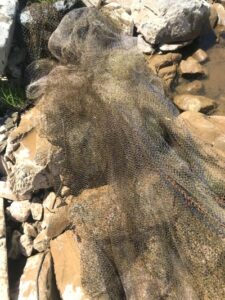
Anyway, I walked several hundred yards downstream and fished a nice series of pools and ripples. I saw more smelt, and lots of nice looking holding water but no trout. At the top of the first ripple I snagged my hook on a very popular method of river fishing in Korea. This net was obviously washed downstream in a flood. Between the nets, dams, irrigation and overall poor water quality fish in Korea do not have it easy.
With some struggle, I could pull the net out of the river. There was two dead smelts in it, and one still struggling. I hate nets at the best of times, but it is a different country with different fishing lures. Almost anything goes on the rivers over here. One traditional fishing method is to smash rocks with sledgehammers to stun the small fish hiding underneath.
With the net safely ashore and destined for the trash. I was free to explore upriver. The river was beautiful, surrounded by oak forests and small hills. I managed to hook and land several chubbs. They are actually a very pretty fish, with a band and bright red fins.
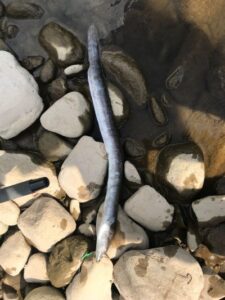
Despite the water looking perfect for trout. I did not see another large fish. I did discover another gill net. This time half buried in sand and wrapped around a short willow tree. Up through a tight gorge I discovered footprints. Human, which suggests another angler, and deer which suggests wildlife.
It was not long until I saw another example of why I dislike freshwater bait fishing. A dead eel suspended in the current, it had swallowed a hook on a ledger rig. I do not know if the eel broke the line, or if the hook was part of a forgotten ‘setline’ in either case the eel was in an advanced state of decomposing. Abandoned baited hooks continue to kill long after they are forgotten about. More rubbish to clean from the river.
I can not end this article on a negative note. This was a stunningly beautiful river to fish. Come autumn, and cooler temperatures I will be back to discover more secrets this river has to offer. Several of the tributaries also look very promising.
